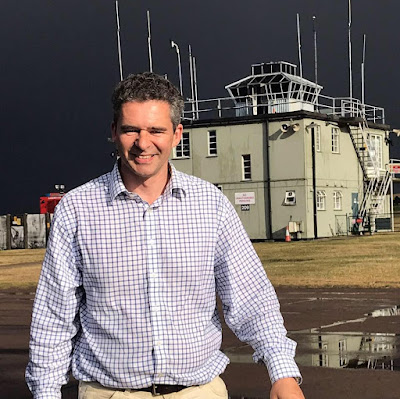BPA: MURDER COVER-UP?
British
Parachute Association Ltd, trading since December 2019 as British
Skydiving, narrowly escaped prosecution for corporate manslaughter over the death of John Ward
in 1991.
When Army Officier Cadet and keen skydiver Stephen Hilder fell to his death in July 2003
after a person or persons unknown cut through the risers of his main and
reserve canopies and the bridle of his drogue parachute, Humberside
Police launched a murder investigation.
 |
Officer Cadet Stephen Hilder: a bright future
|
One
of BPA Ltd's two National Coach and Safety Officers, Tony Butler, told
the coroner's inquest into Hilder's death in March 2005: "I
have investigated sixty deaths in
the UK. The majority of these deaths were caused by collisions or by
deploying the parachute too low. Never in all my years have I come
across any incident like this.".
Testifying as a parachuting accident
investigator, Butler told the inquest into Hilder's death that the BPA inquiry had been
working on the assumption that Hilder's death was murder.
According to former BPA directors and council members, Stephen Hilder was seen as the driving force behind an initiative on the part of younger members to seek election to the BPA Council, take control and impose changes.
These changes would have included a more serious attitude to safety and greater safety-related spending by the BPA, whose published accounts declare a risible annual expenditure of £5,000 or less of the firm's millions. After Hilder's death. this initiative fizzled out and it was business as usual at BPA Ltd.
Meanwhile, the annual death and injury toll through 'normal' accidents continued to rise as the BPA, aided and abetted by the CAA, continued its tenacious evasion of its legal obligations under The Health and Safety at Work Act 1974 and other legislation.
 |
Tony Butler: sixty skydiving fatalities
|
Ten
months into their murder investigation, during which Hilder's two friends and fellow skydivers were
arrested, Humberside Police had suddenly changed tack, claiming that
Hilder had committed suicide by cutting through his risers with a
household scissors taken from the boot of his car by the police evidence
gatherers.
To support their assertion, the police said that the only
DNA found on the scissors came from the dead man and that fibres from
the severed risers were found on the scissors and on Hilder's jumpsuit.
Forensic
scientist Peter Grant told the inquest that someone wearing gloves that
left no DNA traces could have used the scissors. As
for the fibres, Grant remarked that they could have been transferred to
Hilder's jumpsuit as Hilder put his parachute on before his fatal jump. Grant also said: "I
cannot exclude the possibility that someone else cut the straps.".
 Tests
commissioned by the police on a replica of Hilder's skydiving rig found that the only
tool capable of cutting easily through the risers was a double-bladed
hook knife of a type carried by highly experienced skydivers specialising in
canopy-stacking or formation displays. These tests were
not discussed during the official inquest in 2005 or the British Parachute Association's
internal inquiry.
Tests
commissioned by the police on a replica of Hilder's skydiving rig found that the only
tool capable of cutting easily through the risers was a double-bladed
hook knife of a type carried by highly experienced skydivers specialising in
canopy-stacking or formation displays. These tests were
not discussed during the official inquest in 2005 or the British Parachute Association's
internal inquiry.
The investigating detectives had initially reported that Hilder's risers had been cut with "a hook knife". Ten
months into the murder investigation, Humberside Police suddenly
changed tack, stating that Hilder had cut his own risers with a pair of
six-inch scissors found in the boot of his car. In other words, the
police had concluded that Hilder's death was suicide.
Detective Superintendent Colin Andrews
of the Humberside CID, who had been put in charge of the Hilder case,
told the inquest that he did not believe that Hilder was murdered but
added that he "might be wrong about that". To support their sudden
contention that Hilder had taken his own life, D/Supt Andrews and his
team suggested a number of possible motives.
Hilder
was said to be depressed because he believed that he had failed his
annual exams at the Royal Military College of Science. After his death,
it transpired that he had passed his exams. Police also cited the end of
Hilder's relationship with his girlfriend Ruth W––––, who held a
Master's degree in forensic engineering and science. Police said that Hilder had debt of £17,000, most of which involved the purchase of skydiving equipment.
Hilder
is not known to have possessed a hook knife and police reports made no
mention of any knife found with his equipment or his effects. D/Supt Andrews had told the inquest that his officers
had searched for knives in the parachute storeroom after being told that
it was likely that a knife, rather than scissors, had been used on
Hilder's risers.
As any skydiving
specialist could have told the inquest, the household scissors found in
the boot of Hilder's car could not have cut through risers made of
double-thickness nylon webbing designed to support a 1,000 kilogram
loading.
Tony Butler also told the inquest: "Anyone
wanting to
commit suicide would not go through all the drills that Stephen Hilder
carried out.". Replying to Butler, North Lincolnshire Coroner Stewart Atkinson, in an apparent reference to the suicide theory advanced by the police, remarked: "Not unless you wanted it to look like murder.".
Of
the suggestion that Hilder had cut his own risers with the scissors,
Hilder's girlfriend Ruth W–––– said: "If he was going to stage [his own
death], then he
wouldn't just chuck the scissors in the back of the boot.".
She and
Hilder had been in a "light-hearted, relaxed relationship for around
five months", said Miss W––––, contradicting police
assertions about romantic problems in Hilder's life. Asked by Stewart
Atkinson if she believed that Hilder had committed suicide, Miss W––––
replied: "There is no way, there is just no way!".
Paul Hollow, the BPA-rated Chief Club Instructor running the programme at Hibaldstow
that day, told the inquest: "[Hilder] pulled every
handle available to him. I believe that he made every effort to save
himself.".
Hilder
was just twenty years old when he fell to his death in a cornfield near
Hibaldstow airfield in northern Lincolnshire on July 4th 2003. Hilder
had exited the aircraft at 13,000 feet with Adrian B––– and David M––– a
fellow army officer cadet at the Royal Military College of Science in
Shrivenham, Wiltshire. The three skydivers belonged to the Black Rain
skydiving team.
M–––– said afterwards: "[Hilder] seemed excited when we were doing the last jump. He was like that the whole way down. In formation skydiving
you want to make eye contact. Just making eye contact he seemed as
happy as all of us. The jump hadn't started well but then we got things
right and we were performing really well.".
The
three skydivers performed various manoeuvres together before separating
at 4,000 and opening their parachutes. Neither Hilder's main nor
reserve parachutes opened. Hilder's risers –– the double thickness nylon
webbing straps to which the rigging lines of each parachute were
attached –– and the bridle of his drogue parachute were found to have been cleanly cut through.
Stephen
Hilder's
equipment had been sabotaged yet Coroner Stewart Atkinson recorded an
Open Verdict. Atkinson said that there was no proof that Hilder had been
murdered but that he remained unpersuaded that Hilder had committed
suicide. Atkinson's verdict struck many observers as incomprehensible.
Given the deliberate sabotage of Hilder's skydiving rig, how could a
coroner rule out murder or suicide?
Atkinson
was unequivocal regarding his rejection of the police suicide theory.
Before he announced his Oper Verdict, Atkinson said: "There
were a number of issues in [Hilder's] life but that does not persuade me
that
he killed himself.". Some observers wondered if Atkinson had been
pressured by Humberside Police into ruling out murder as the cause of
death.
Humberside
Police had arrested David M–––– on suspicion of murder. Adrian B––––
was also arrested as an accessory and also on suspicion of making a
snuff movie because he had videoed the jump. In fairness to Humberside
Police, M–––– had not done himself any favours by composing a humorous
draft obituary about Hilder, which police found on his computer. M––––
later said: "I think, after the hassle it has caused, I would prefer not
to have written it.".
M––––
had also testified to the inquest about pranks he and other members of
the team played on Hilder. A fortnight before Hilder's death, M–––– and
another team member had removed a retaining pin from Hilder's parachute
rig.
M–––– told the inquest: "I
assumed that he would have seen what had been done straight
away. It was a way of highlighting that his kit had been left in a
completely unsafe area. What we did meant he would have to unpack and
repack his kit which would take him about fifteen minutes.". M–––– also
said that he and B***** found Hilder annoying because he followed the
British Parachute Association's safety manual to the letter. M–––– said:
"Stephen was very safety-conscious.".
Paul Hilder, father of Stephen Hilder, told the BBC and other media: "Stephen's
life has been dissected and examined in great detail and we still do
not know why he died. We do not know why anyone would want to
kill him, nor is there evidence that he took his own life.".
One of the CID detectives on D/Supt Andrews' team commented anonymously to a Yorkshire Post reporter: "Nothing we have discovered
during the investigation and no-one we have interviewed has said
anything to suggest Stephen may have been contemplating killing
himself.". So, not all of the police detectives involved in the murder investigation agreed with the improbable suicide theory.
 |
D/Supt Andrews: witness intimidation
|
Investigated
a few years later by his own force's anti-corruption unit and then by
anti-corruption officers from Durham Constabulary, Colin Andrews was prosecuted and jailed for twelve months in 2015 for harassment, aggravated stalking, common assault and witness intimidation. Andrews was, however, cleared of rape.
Andrews
had forced his attentions on two women despite their objections, citing
his rank and power when telling them that nobody would believe their
word against his. Manchester Crown Court heard that the thirty-year
police veteran had "sociopathic tendencies" and was "a controlling,
manipulative bully.".
Former
Detective Chief Inspector Mark Oliver told the court "Officers were
concerned about the dirt Mr Andrews would raise if he was prosecuted.
Chief Superintendent Heaton was worried about the reputation of
Humberside Police and worried specifically about salacious details that
Colin Andrews knew and whether they would be used as mud-slinging to
defend himself.".
Whilst the question of murder or suicide was examined, nobody raised the question
of negligence in the failure to impose basic safety checks on Hilder and his equipment before he emplaned. At
no time during his testimony did BPA Ltd's National Safety Officer Tony
Butler or any other experienced skydiver challenge the police
contention that Hilder was able to cut through his four risers with the
scissors.
One former BPA Ltd director and councillor of twenty-seven years' standing told BPA Watch: "The BPA has evaded negligence lawsuits and corporate manslaughter charges over and over again
through dirty deals, out of court settlements and non-disclosure
agreements.
"CAA
senior management don't want to rock the boat because of the history
fatalities, accidents and cover-ups like the Stephen Hilder case. And the John Ward case in 1991.
The BPA has evaded negligence lawsuits and corporate manslaughter charges over and over again
through dirty deals, out of court settlements and non-disclosure
agreements.".
BPA
Watch asked Tony Butler –– now BPA Ltd's Chief Operations Officer –– if
the suicide theory advanced by Humberside Police suited BPA because it
placed the blame squarely on Hilder, thereby reducing the possibility
being sued by Hilder's family. As in other cases, Butler did not
respond.
Butler has spoken of his
involvement in investigating sixty skydiving-related
fatalities since 1982. Like Butler himself during his testimony to the Stephen Hilder inquest, experienced BPA
skydivers and instructors attribute most of these fatalities to bad
canopy handling skills, which they attribute in turn to the lack of
suitable training and retraining courses.
 |
BPA: Murder cover-up?
|
In
an unrelated discussion with BPA Watch, a prominent Parachute Training
Organisation operator who has clashed with BPA Ltd's directorate in the
past over the Association's troubling safety record said: "The
BPA spends shockingly little on safety and safety training every year.
Just look at the annual returns. There should be far more emphasis on
training and annual retraining of BPA instructors and examiners.".
In
2018-2019, BPA Ltd spent £208,975 on "operating costs" in addition to
£333,449 on "staff costs", which include the six-figure salary
reportedly paid to Butler who is widely seen as BPA Ltd's ghost CEO.
Conversely,
BPA Ltd spent £2,129 on "safety". A
further £1,395 was spent on "manuals, safety information and badges".
An experienced BPA-rated parachute instructor, who asked to remain anonymous to protect his BPA ratings, told BPA Watch: "Steve
Hilder allegedly cut his pilot chute bridle with a pair of cheap-o
scissors, both of his reserve parachute risers, and steering toggles and
Velcro in one go, some quite heavy-duty webbing, tucked everything into
his rig and proceeded to jump in a 3-way competition.
"Observers state it
was the best jump the team had completed, with the descent captured on
video. The
cameraman was arrested for making a snuff movie but these charges were later
dropped. One thing is sure, though: if Steve and his kit had been
properly checked outside and inside the aircraft, he would not have died
that day.". The inquest into Hilder's death was told that Hilder refused to let anyone check his equipment.
On its website, BPA Ltd trading as British Skydiving confirms that it "controls all
aspects of
skydiving on behalf of the Civil Aviation Authority (CAA).". One former BPA
Council member said: "The business
relationship between the BPA and the CAA is run behind closed doors by
Tony Butler and the CAA's Gordon Duncan. It's been that for years. Duncan signs off on anything
Butler puts in front of him. And Duncan is protected by his bosses.
 |
CAA manager George Duncan: BPA poodle?
|
"The
BPA
is allergic to Health and Safety regulations and Butler has openly said
that they want no dealings with the Health and Safety Executive.
The CAA management from the top down knows
this because they've been warned about it but they do nothing. They're
complicit. Just read the latest CAP660 from March this year:
where's the Health and Safety stuff you find in other CAPs? ".
Why
was the murder investigation dropped? Were there two many potential
suspects? Did the police realise that they had failed to observe basic
crime scene procedures when they arrived at Hibaldstow? Or was there a
cover-up to protect someone and, if so, who was covering up for whom?
Whether
ex-Detective Superintendent Andrews was ordered to quash the murder
investigation or did so on his own initiative may never be known but it
seems clear that someone wanted Hilder's murder written off as suicide. None
of Hilder's relations or friends objected openly to the
strangely-worded open verdict rendered by a coroner who seemingly came
under pressure to validate the suicide theory. Is it possible that they
were subjected to intimidation by Andrews?
Why did the British Parachute Association fail to object to the
fantastic police assertion that young Stephen Hilder cut through four
1,000 kg nylon risers with a set of household scissors? Did D/Supt
Andrews have "dirt" any of the BPA directors and, if so, what kind of
dirt?
Coroner Stewart Atkinson
said that Hilder's death was neither murder nor suicide and had the
cheek to tell Hilder's family that he hoped his open verdict would bring
them peace and closure. But someone cut Hilder's parachute straps that
weekend. Perhaps Hilder was not the intended target but if it was not
suicide, then it must have been murder, even if Hilder might not have been the
target.
Don Canard



















